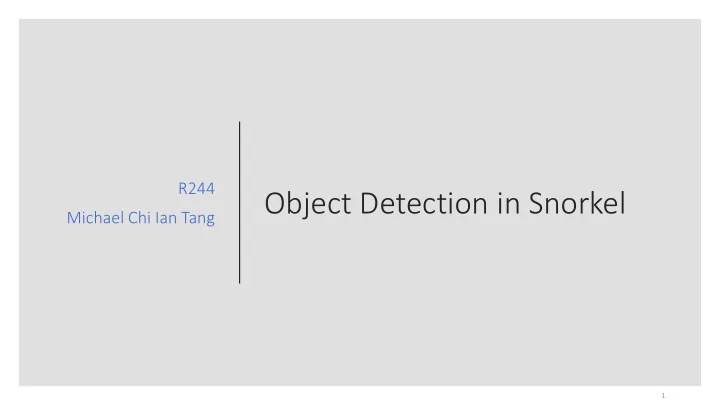

R244 Object Detection in Snorkel Michael Chi Ian Tang 1
Snorkel 2
Data Programming – Labelling functions • Express knowledge as labelling functions • Can have unknown accuracies and correlations • Assign a class label or abstain 3
Generative Model • Probabilistic Model • Optimized by minimizing the negative log marginal likelihood given the observed label matrix Λ • Generate probabilistic training labels 4
Overview 5
Object Detection 6
Object Detection • Localize and classify objects in an image • Multiclass & Variable number of labels 7
Architectures • Region-based Convolutional Network • R-CNN (2014), Fast R-CNN (2015), Faster R-CNN (2015), R-FCN (2016) • More accurate, Slow • You Only Look Once (YOLO) • YOLO (2016), YOLOv2 (2016), YOLOv3 (2018) • Less accurate, Real-time 8
Object Detection in Snorkel 9
Approach • Regions as candidates • Models as labelling functions • Combining labels from different detection models • Extension with image classification models • Augmenting the dataset with new images 10
Regions as candidates • Each detected region is treated as a candidate 𝑦 1 ⋮ 𝑦 𝑗 11
Models as labelling functions • Treat each trained model as a labelling function 12
Combining labels from different models • Object detection models • Combine regions based on IoU (intersection over union) measure • Abstain for non-detected regions 13
Extension with image classification models • Apply simple image classification models to the candidate regions 14
Augmenting the existing dataset • Train a generative model based on the labels • New training samples from new images using the generative model 15
Evaluation • Retrain existing machine learning models with augmented dataset • Effects of extra data • Effects of using probabilistic labels • Manual investigation of random samples 16
Recommend
More recommend